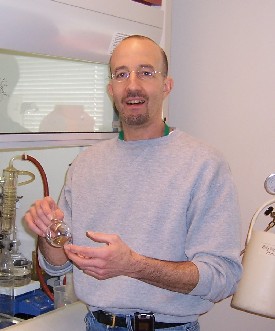Our Science – Barchi Website
Joseph J. Barchi Jr., Ph.D.
 |
|
|||||||||||||||||||||||||
Biography
Dr. Barchi received his Ph.D. in Organic Chemistry from the University of Hawaii with Richard E. Moore and did 2 years of postdoctoral work at Duke University with Bert Fraser-Reid. He then joined the NCI as a staff fellow in 1988, was promoted to staff scientist and then to senior scientist in 2002. His main research interests are in synthetic medicinal chemistry as it relates to carbohydrate-based drug design, and the high-resolution structural analysis of sugars, glycopeptides and small molecule drug candidates by NMR spectroscopy.
Research
Multivalent Presentation of Tumor-Associated Carbohydrate Antigens (TACA) and TACA-Peptide Conjugates as Modulators of Tumor Cell Adhesion and Novel Immunogens
Carbohydrates are presented on the surface of cells primarily in covalent linkages to proteins (glycoproteins, proteoglycans) or lipids (glycolipids, gangliosides. These diverse groups of oligosaccharide chains function to stabilize protein structures, facilitate protein transport or clearance, and mediate cell adhesion. Cell-surface glycans may reveal or mask peptide epitopes on proteins or be recognized as immunogenic structures themselves. During oncogenesis, the cell-surface glycans on tumor cells are transformed relative to the normal phenotype through modified expression of the enzymes involved in the cell's glycoprocessing machinery. These aberrations are a hallmark of highly tumorigenic and metastatic cell types. The cascade of events leading to tumor metastasis is marked by the alternate adhesion and release of the tumor cell with a variety of surrounding cell types. The binding between tumors and other cell types is often mediated by carbohydrate-protein (lectin) interactions involving the aberrant glycans expressed on tumor cells. Inhibition of these adhesion events could slow or prevent metastatic spread. In addition, some of these tumor cell glycans are TACA's that are recognized as non-self by the immune system and have thus been used as components in vaccine constructs that are in clinical trials. Since it is well known that monovalent sugar-protein binding is a very weak interaction, inhibitors of these events utilize 'multivalency' (multiple copies of the carbohydrate ligand) to enhance the strength of this effect. We are exploring ways to synthesize novel templates on which to place multiple copies of the Thomsen Freidenreich (Tf) antigen, a disaccharide O-linked to proteins found on the cell surface that is present in >90% of carcinomas but rarely found in normal tissue. We have developed a new synthesis of this antigen that is equipped with a conjugatable linker to attach to macromolecules or other surfaces. We attached Tf antigen to gold surfaces and showed that this construct attached strongly to a Tf-binding peptide. In addition, our group discovered a new synthesis of Tf-encapsulated Quantum Dots (QD). These are new semiconductor nanocrystals that have size-dependent optical properties that make them extremely useful as biological imaging agents. These novel sugar-coated particles are also being explored as potential immunogens to raise high titer antibodies to Tf antigen. The preparation of glycopeptides containing the Tf disaccharide that are displayed on gold or QD particles is now being investigated. It is hoped that the combination of the peptide and the covalently linked carbohydrate will generate a glycopeptide-specific immune response that will be mmore powerful than either single antigen alone.
Conformational Analysis of Drug Candidates by NMR Spectroscopy
The LMC synthesizes small molecule agents potential anticancer or antiviral therapeutics. Our section uses NMR spectroscopy to determine 3-dimensional connformations of many of these candidates as an aid to structure-based drug design. Currently, a major area of research has focused on the global conformational changes imparted to small DNA duplexes by inclusion of conformationally constrained base pairs. These nucleoside analogues were synthesized in the LMC (see Marquez group home page) and incorporated into a standard B-DNA sequence. The analogues were designed to force an A-DNA like motif in the center of the duplex. NMR data has allowed us to define any additional bending in the overall duplex that is caused by the base 'mutations'. The goal is to design oligonucleotides that are predisposed to different bend angles and may mimic the deformations caused when specific gene sequences bind to proteins (e.g., transcription factors)
This page was last updated on 7/15/2008.

